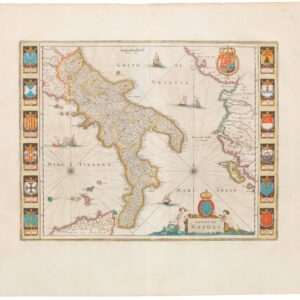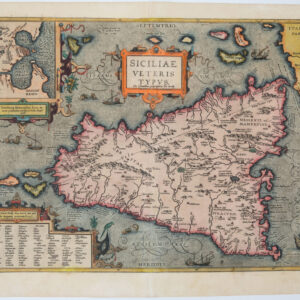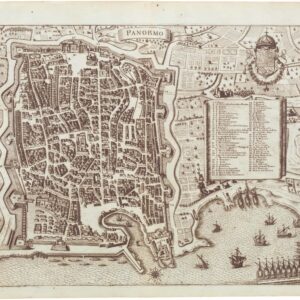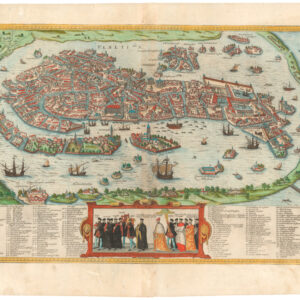1587 Ortelius six maps in one: Sicily, Malta, Sardinia, Corfu, Elba, and Djerba.
Insularum Aliquot Maris Mediterranei Descriptio
$650
In stock
Description
From the rare French edition (estimated only 250 copies), this is six early maps of Mediterranean islands on one sheet: Sicily, Malta, Sardinia, Corfu, Elba, and Djerba (Zerbi).
The bigger islands need no introduction, but perhaps Djerba and Elba are less well known. Djerba is an island off the coast of Tunisia. It is said to be the mythical location of the lotus-eaters in The Odyssey. The local architecture has a distinctive style that influenced the makers of Star Wars. The mountain range shown in this map is invented; the island is basically flat, with an average elevation of 20 meters and a high point of 53 meters.
For its part, one interesting chapter in the history of Elba occurred in 1814, when Napoleon was sent there in exile. He stayed on the island for about a year before the famous period of the Hundred Days, which included the War of the Seventh Coalition, the Neapolitan War, as well as several other minor campaigns. With his defeat at the Battle of Waterloo in 1815, Napoleon was once again exiled, this time to the remote Atlantic island of St. Helena.
Several of the maps include ships at sail. The map of Malta depicts a sinking ship at Cala di S. Paulo, where Saint Paul is supposed to have shipwrecked and landed.
Cartographer(s):
Abraham Ortelius (1527-1598) was born in Antwerp to Flemish parents in 1527. After studying Greek, Latin, and mathematics, he and his sister set up shop as book dealers and a ‘painter of maps.’ In his heart, Ortelius was, nevertheless, first and foremost a historian. He believed geography was the ‘eye of history,’ which explains why he collected maps and historical documents with such passion. Ortelius traveled widely in pursuit of his interests, building contacts with mapmakers and literati all over the European continent.
Ortelius reached a turning point in his career in 1564 with the publication of a World Map in eight sheets, of which only a single copy survives. In 1570, he published a comprehensive collection of maps titled Theatrum orbis terrarum (Theatre of the World). The Theatrum is conventionally considered the first modern-style atlas. It was compiled by collecting maps and charts from colleagues across the continent, which Ortelius then had engraved in a uniform size and style. The engraver for most of the maps in Theatrum was none other than the famous Frans Hogenberg, who also served as the main engraver for the 16th-century urban atlas Civitates Orbis Terrarum, published with Georg Braun in 1572.
Hogenberg’s re-drawn and standardized maps formed the basis of the first atlas in history (even though it was Mercator who was the first to use the term a few decades later). Unlike many of his contemporaries, Ortelius noted his sources openly and in the first edition, acknowledged no less than eighty-seven different European cartographers. This ‘catalogus auctorum tabularum geographicum‘ is one of the major innovations of his atlas. The list of contributing mapmakers was kept up-to-date for decades after Ortelius’ death. In the first edition of 1570, this list included 87 names, whereas the posthumous edition of 1603 contained no less than 183 names.
While compiled by Abraham Ortelius in the manner described above, the Theatrum was first printed by Gielis Coppens van Diest, an Antwerp printer experienced with cosmographical books. Van Diest was succeeded by his son Anthonis in 1573, who in turn was followed by Gillis van den Rade, who printed the 1575 edition of Ortelius’ atlas. From 1579, Christoffel Plantin took over, and his successors continued to print Theatrum until Ortelius’ heirs sold the copperplates and the publication rights to Jan Baptist Vrients in 1601. In 1612, shortly after Vrients’s death, the copperplates passed to the Moretus brothers.
Condition Description
Some paper toning. Nice, wide margins; heavy paper with a watermark of what looks to be a crown.
References
Van den Broecke 141.




